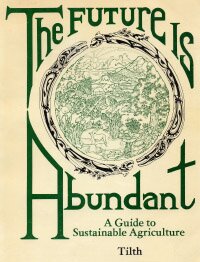
The Future is Abundant
A Guide to Sustainable Agriculture
Tilth Producers of Washington Home | WA Tilth Assoc. | Conference | Directory | Journal | Placement Service | Calendar | Action Alerts
Legislative Update | Bulletin Board | Classifieds | Questions on Agriculture? | Photo Gallery | Links | Contact Us | Join Now | Volunteer

Bill Schildgen has spent the last 16 years developing a nut orchard which successfully integrates upper and middle-story plants. Located on the north shore of a large lake in northeastern Washington a few miles south of the British Columbia border, the elevation of Bill's land is slightly over 1,000 feet. The mountains surrounding the lake are steep and rocky and reflect heat and sunlight back into the valley where the orchards are. The lake to the south and the northern rocky slopes also reflect heat into the orchard creating an ideal microclimate for nut trees.
The upper story of the nut orchard consists of walnuts, Chinese chestnuts, heartnuts and a few Turkish tree hazels (Corylus colurna). The middle story is composed mainly of filberts, with some pears, peaches and plums. The south side of the orchard is planted to peaches and nectarines to take advantage of the warm, sunny exposure. On the west side grapes have been trained along hte high deer fence which surrounds the orchard. Clematis grows along the fence on the east side.
The filbert trees grow long-limbed and less productive as the walnut overstory grows in height and the shade deepens. The productivity of the filberts is maintained by periodically thinning some of the walnut trees, allowing more sunlight to reach the middle story. Bill has found that spacing the walnut trees 60 feet apart and the filbert trees 25 feet apart is ideal for both crops. Most commercial walnut orchards are planted with trees 40 feet apart.
Bill speeds up his breeding results by hand pollinating selected trees and planting the nuts which result. After one year of growth, buds from the most prominent seedlings are grafted onto bearing trees. These buds can bear nuts as early as the following year. In this way the type of nut a new tree will bear can be determined years before it would normally have come into bearing. He points out, however, that for every exceptional nut cultivar he creates through breeding, he creates hundreds of others which are not worthy of continued propagation. Some of Bill's trees have over 50 varieties of nuts grafted onto them and most have at least a dozen.
Bill's nut breeding experiments have resulted in many unusual and promising varieties. His Chopaka and Cascade walnuts are twice the size of an ordinary walnut. he has successfully crossed the domestic filbert with the Turkish tree hazel, thus producing a filbert capable of growing into a tall tree. One of his current projects is to produce a successful hybrid between the English walnut and the Japanese heartnut.
Bill has built and set out owl boxes along the edge of the orchard. The owls help control mice and other rodents which enjoy the bark of young walnut trees. He also keeps 50 to 75 hives of bees to pollinate the orchard trees and to harvest the nectar from the flowers which appear in the surrounding wildlands.
Bill Schildgen's multi-story orchard demonstrates some of the many possibilities for designing a permanent agriculture. The advantage of the orchard's topographic position has certainly contributed to its success, but it is also the result of the patient care of someone who delights in working with plants.
Tilth Producers of Washington Home | WA Tilth Assoc. | Conference | Directory | Journal | Placement Service | Calendar | Action Alerts
Legislative Update | Bulletin Board | Classifieds | Questions on Agriculture? | Photo Gallery | Links | Contact Us | Join Now | Volunteer